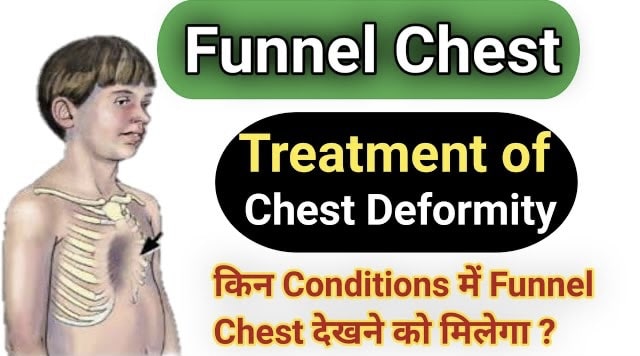What is Funnel Chest
Funnel chest also known as pectus excavatum is a congenital condition where the breastbone (sternum) and the ribs grow abnormally causing the chest to appear sunken or concave.
It is one of the most common chest wall deformities affecting about 1 in 300-400 people.
The exact cause of funnel chest is not fully known but it is believe that the combination of genetic and environmental factors.
The condition may be present at birth or become more noticeable during puberty when growth spurts occur.
In some cases funnel chest can be associate with connective tissue disorders or other underlying medical conditions.
Funnel Chest severity
In mild cases it may not cause significant health problems and might only be a cosmetic concern.
However in more severe cases it can compress the heart and lungs leading to symptoms
such as difficultyin breathing , reduced exercise tolerance and chest pain.
These symptoms are typically exacerbate during physical activity or when the individual is lying flat.
Funnel Chest Treatment
Treatment options for funnel chest depend on the severity of the condition and the presence of symptoms.
In mild cases without significant symptoms, no treatment may be necessary.
For moderate to severe cases treatment options may include:
Observation:
If the condition is not causing any significant health issues or discomfort, a doctor may recommend regular monitoring without intervention.
Physical therapy:
Certain exercises and techniques can help improve posture and strengthen the muscles around the chest
which may help minimize the appearance of the funnel chest.
External chest bracing:
In some cases specially design braces can be wear to apply gentle pressure to the chest over time gradually reshaping it.
This method is often use in children and adolescents with growing bones.
Surgery:
For severe cases or when other treatments are ineffective, surgical intervention may be consider.
The most common surgical procedure for funnel chest is known as Nuss procedure
which involves inserting a curved metal bar under the sternum to elevate it and reshape the chest.
Another surgical option is the Ravitch procedure which involves removing cartilage and reshaping the sternum.
It is important to consult with a medical professional to determine the best course of action for individual cases of funnel chest.
They can provide a proper diagnosis evaluate the severity of the condition and discuss the available treatment options.
Funnel Chest Brace
A funnel chest brace also known as a chest compression brace or vacuum bell is a non-surgical treatment option for individuals with mild to moderate funnel chest (pectus excavatum).
Vaccum bell device Buy link – https://vacuumbell.net/
The purpose of the brace is to apply external pressure to the chest wall in order to gradually correct the concave shape and improve the appearance.
The funnel chest brace typically consists of a plastic or silicone cup-shaped device which is place over the affected area of the chest.
The device will connected to a vacuum pump that creates suction pulling the chest outward and applying gentle pressure.
This helps to remodel the chest wall over time by stimulating the growth of cartilage and soft tissues in the desired direction.
The brace is usually wear for several hours each day and the duration of treatment can vary depending on the severity of the condition and the individual response to the treatment.
It is important to follow the instructions provided by the healthcare professional and have regular check-ups to monitor progress.
It’s worth noting that the effectiveness of a Condition brace can vary from person to person and it is generally more effective in younger individuals with more flexible cartilage.
In some cases the brace may be use as a preparatory treatment before surgical intervention or as a post-operative support to maintain the correct shape after surgery.
It is crucial to consult with a healthcare professional who specializes in treating chest wall deformities.
They can evaluate the severity of the condition and recommend the most appropriate treatment plan which may include the use of a brace or other interventions.
Funnel Chest Exercise
While exercise cannot correct the underlying structural abnormality of funnel chest (pectus excavatum)
certain exercises and techniques can help improve posture, strengthen the surrounding muscles and potentially minimize the appearance of the condition.
Here are a few exercises which may be Usefull:
Deep Breathing Exercises:
Deep breathing exercises can help improve lung capacity and chest expansion.
Sit or stand tall, inhale deeply through your nose, expanding your chest and abdomen and exhale slowly through your mouth.
Repeat this exercise several times a day.
Upper Body Strengthening:
Strengthening the muscles in your upper body can help improve posture and provide better support to your chest.
Some exercises that target the upper body include push-ups, chest presses, shoulder presses and rows.
You can use resistance bands, dumbbells or bodyweight for these exercises.
Core Exercises:
Strengthening your core muscles can help improve overall posture and alignment.
Exercises such as planks, side planks, Russian twists and abdominal crunches can be beneficial.
Engaging your core muscles during other exercises and activities can also provide added support to your chest.
Stretching Exercises:
Stretching exercises which can help in improving flexibility & posture.
Focus on stretching your chest, shoulders and back muscles.
Some effective stretches include doorway stretches, pectoral stretches and thoracic spine stretches.
Posture Correction:
Being mindful of your posture throughout the day can make a difference in the appearance of funnel chest.
Try to maintain an upright posture with your shoulders back and down. Avoid slouching or hunching forward.
It is important to note that while these exercises can help improve posture and muscle strength they may not significantly alter the structural appearance of funnel chest.
If you are concerned about the condition or experiencing symptoms
it is advisable to consult with a healthcare professional who specializes in chest wall deformities.
They can provide a proper evaluation and recommend the most appropriate treatment options for your specific situation.
Read our Intresting article on Pigeon chest – Kindly Click here
